Heinrich J.G., Aldinger F. (Eds.) Ceramic Materials and Components for Engines
Подождите немного. Документ загружается.

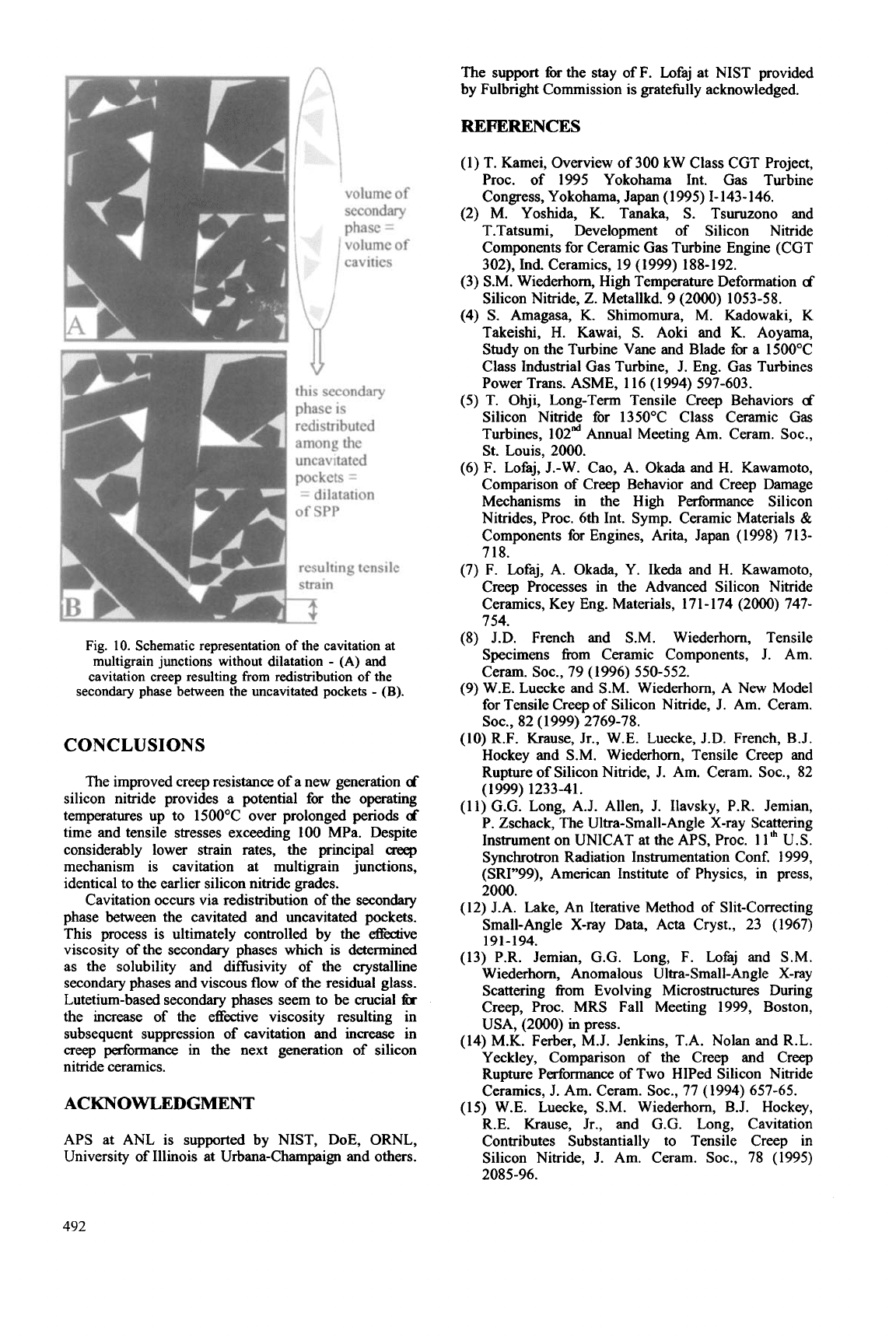
The support
tbr
the stay of F. Lofaj at NIST provided
by Fulbright Commission is gratefilly acknowledged.
REPERENCES
(1) T. Kamei, Overview of 300 kW Class CGT Project,
Proc. of 1995 Yokohama Int. Gas Turbine
Congress, Yokohama, Japan (1 995)
I-
143- 146.
(2) M. Yoshida, K. Tanaka,
S.
Tsuruzono and
T.Tatsumi, Development of Silicon Nitride
Components for Ceramic Gas Turbine Engine (CGT
302), Ind. Ceramics, 19 (1999) 188-192.
(3) S.M. Wiederhorn, High Temperature Deformation
d
Silicon Nitride,
Z.
Metallkd.
9
(2000) 1053-58.
(4)
S.
Amagasa, K. Shimomura, M. Kadowaki,
K
Takeishi, H. Kawai,
S.
Aoki and K. Aoyama,
Study on
the
Turbine Vane and Blade for a 1500°C
Class Industrial Gas Turbine, J. Eng. Gas Turbines
Power Trans. ASME, 116 (1994) 597-603.
(5)
T. Ohji, Long-Term Tensile Creep Behaviors
d
Silicon Nitride for 1350°C Class Ceramic Gas
Turbines, 102" Annual Meeting Am. Ceram. SOC.,
St. Louis, 2000.
(6)
F. Lofaj, J.-W. Cao, A. Okada and
H.
Kawamoto,
Comparison of Creep Behavior and Creep Damage
Mechanisms in the High Performance Silicon
Nitrides, Proc. 6th Int. Symp. Ceramic Materials
&
Components for Engines, Arita, Japan (1998) 7 13-
718.
(7)
F.
Lofaj, A. Okada,
Y.
Ikeda
and H. Kawamoto,
Creep Processes in the Advanced Silicon Nitride
Ceramics, Key Eng. Materials, 17 1
-
174 (2000) 747-
754.
(8) J.D. French and S.M. Wiederhom, Tensile
Specimens from Ceramic Components, J. Am.
Ceram. SOC., 79 (1996) 550-552.
(9)
W.E. Luecke and S.M. Wiederhom, A New Model
for Tensile Creep of Silicon Nitride, J. Am. Ceram.
(10) R.F. Krause, Jr., W.E. Luecke, J.D. French, B.J.
Hockey and S.M. Wiederhom, Tensile Creep and
Fig. 10. Schematic representation
of
the cavitation at
multigrain junctions without dilatation
-
(A)
and
cavitation creep resulting
from
redistribution
of
the
secondary phase between the
uncavitated
pockets
-
(B).
SOC., 82 (1999) 2769-78.
CONCLUSIONS
The improved creep resistance of a new generation
d
silicon nitride provides a potential for
the
operating
temperatures up to 1500°C over prolonged periods
of
time and tensile stresses exceeding 100 MPa. Despite
considerably lower strain rates, the principal
aeq~
mechanism is cavitation at multigrain junctions,
identical to the earlier silicon nitride grades.
Cavitation occurs via rehstribution of
the
secondary
phase between the cavitated and uncavitated pockets.
This process is ultimately controlled by the effectve
viscosity of the secondary phases which is determined
as the solubility and hffusivity of the crystalline
secondary phases and viscous flow of the residual glass.
Lutetium-based secondary phases seem to be crucial
for
the increase of the effective viscosity resulting in
subsequent suppression
of
cavitation and increase in
creep performance in the next generation
of
silicon
nitride ceramics.
ACKNOWLEDGMENT
APS at ANL is supported by NIST,
DOE,
ORNL,
University of Illinois at Urbana-Champaign and others.
Rupture of Silicon Nitride, J. Am. Ceram.
Soc.,
82
(11) G.G. Long, A.J. Allen, J. Ilavsky, P.R. Jemian,
P. Zschack, The Ultra-Small-Angle X-ray Scattering
Instrument on
UNICAT
at the APS, Proc. 1 lIh
U.S.
Synchrotron Radiation Instrumentation Conf.
1
999,
(SRI"99), American Institute of Physics, in press,
2000.
(12) J.A. Lake, An Iterative Method of Slit-Correcting
Small-Angle X-ray Data, Acta Cryst., 23 (1967)
(13) P.R. Jemian, G.G. Long, F. Lofaj and S.M.
Wiederhorn, Anomalous Ultra-Small-Angle X-ray
Scattering ftom Evolving Microstructures During
Creep, Proc. MRS Fall Meeting 1999, Boston,
USA, (2000)
in
press.
(14) M.K. Ferber, M.J. Jenkins, T.A. Nolan and R.L.
Yeckley, Comparison of the Creep and Creep
Rupture Perfomance of Two HIPed Silicon Nitride
Ceramics, J. Am. Ceram. SOC., 77 (1994) 657-65.
(15) W.E. Luecke, S.M. Wiederhom, B.J. Hockey,
R.E. Krause, Jr., and G.G. Long, Cavitation
Contributes Substantially to Tensile Creep in
Silicon Nitride, J. Am. Ceram. SOC., 78 (1995)
(1999) 1233-41.
19
1
-
194.
2085-96.
492

(16)
F.
Lofaj, A. Okada and
H.
Kawamoto, Cavitational (18)
F.
hfaj,
P.R.
Jemian, J. Ilavsky,
G.G.
Long and
Strain Contribution to Tensile Creep
in
Vitreous S.M. Wiederhom, Evolution
of
Cavities
During
Bonded Ceramics, J.Am.Ceram.Soc., 80 (1997) Creep
in
Silicon Nitride by Anomalous Ultra-Small
16 19-23.
Angle X-ray Scattering,
102"d
Annual Meeting Am.
(17) J.-W. Cao,
F.
hfaj and A. Okada, Application
of
Ceram. SOC., St. Louis,
2000.
an Ultrasonic Technique to Creep Cavitation in
Silicon Nitride, J. Mater. Sci.,
in
press.
I
493

This Page Intentionally Left Blank
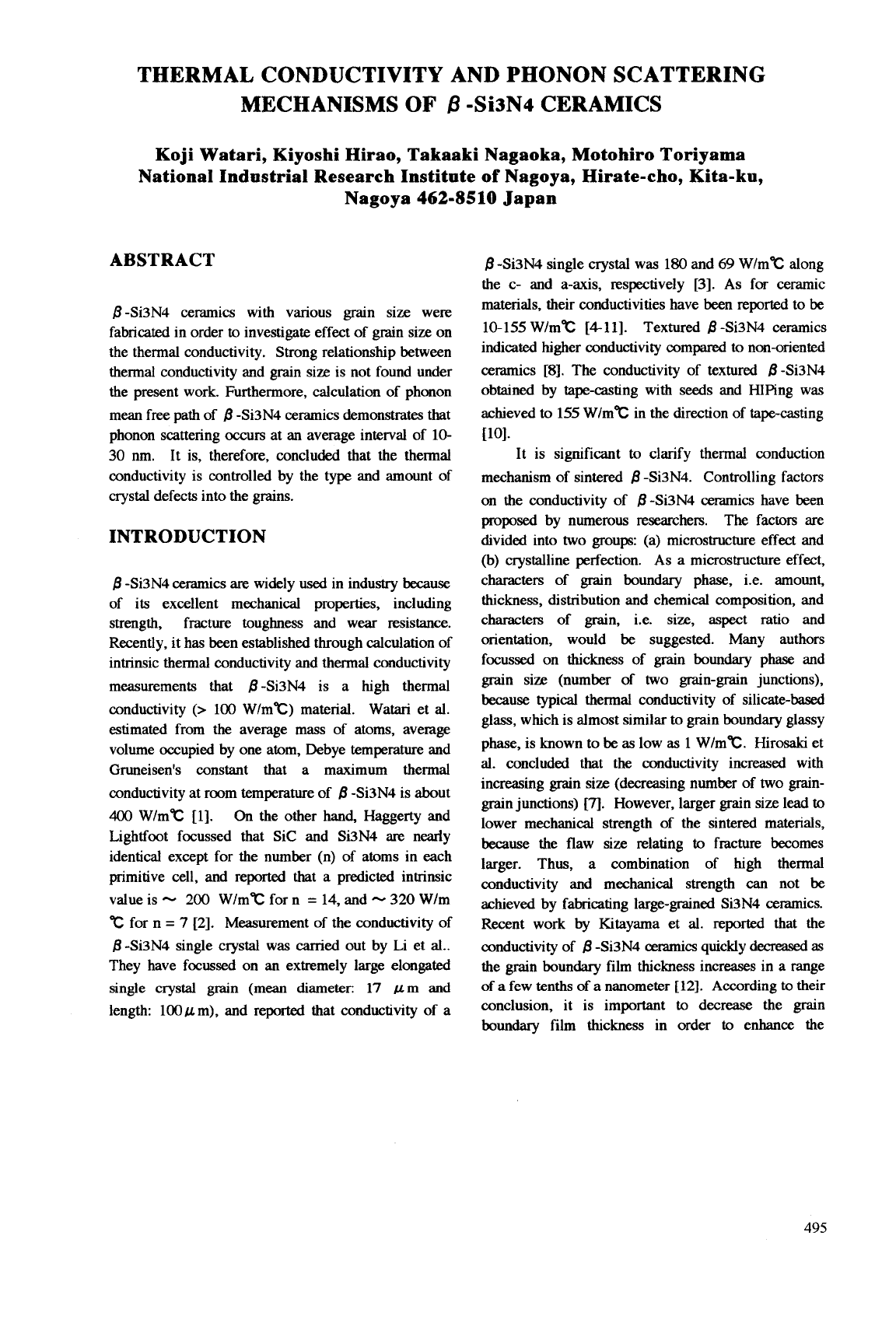
THERMAL CONDUCTIVITY AND PHONON SCATTERING
MECHANISMS
OF
B
-Si3N4 CERAMICS
Koji Watari, Kiyoshi Hirao, Takaaki Nagaoka, Motohiro Toriyama
National Industrial Research Institute
of
Nagoya, Hirate-cho, Kita-ku,
Nagoya
462-8510
Japan
ABSTRACT
B-Si3N4 ceramics with various grain size were
fabricated in order
to
investigate effect of grain size on
the thermal conductivity. Strong relationship between
thermal conductivity and grain size is not found under
the present work. Furthermore, calculation of phonon
mean
free
path of
B
-Si3N4 ceramics demonstrates that
phonon scattering
occurs
at an average interval of
10-
30
nm.
It is, therefore, concluded that the thermal
conductivity is controlled by the type and amount of
crystal defects into the grains.
INTRODUCTION
B
-Si3N4 ceramics
are
widely
used
in industry
because
of its excellent mechanical properties, including
strength, fracture toughness and wear resistance.
Recently, it has been established through calculation of
intrinsic thermal conductivity and thermal conductivity
measurements that B-Si3N4 is
a
high thermal
conductivity
(>
100
W/m"C) material. Watari et al.
estimated from the average mass of atoms, average
volume occupied by one atom, Debye temperature and
Gruneisen's constant that
a
maximum thermal
conductivity at room temperature of
B
-Si3N4
is
about
400
W/m"C
[l].
On
the other hand, Haggerty and
Lightfoot focussed that
Sic
and Si3N4
are
nearly
identical except for the number (n) of atoms in each
primitive cell,
and
reported that
a
prdcted intrinsic
value is
-
200
W/m"C for n
=
14,
and
-
320
W/m
C
for n
=
7
[2].
Measurement of the conductivity of
B-Si3N4 single crystal was
carried
out by Li et al..
They have focussed on an extremely large elongated
single
crystal
grain (mean diameter:
17
wm and
length:
100km),
and reported that conductivity of
a
B
-Si3N4 single crystal was
180
and
69
W/m"C along
the
c-
and
a-axis,
respectively
[3].
As
for
ceramic
materials, their conductivities have been
reported
to
be
10-155
W/m"C
[4-111.
Textured B-Si3N4 ceramics
indicated higher conductivity compared to non-oriented
ceramics
[8].
The conductivity of textured B-Si3N4
obtained by tape-casting with
seeds
and HIPing was
achieved to
155
W/m"C in the direction of tape-casting
It is significant to clarify thermal conduction
mechanism of sinkred
B
-Si3N4. Controlling factors
on the conductivity of B-Si3N4 ceramics have been
proposed
by numerous researchers. The factors are
divided into two groups: (a) microstructure effect and
(b) crystalline perfection.
As
a
microstructure effect,
characters of grain boundary phase, i.e. amount,
thickness, distribution and chemical composition, and
characters of grain, i.e. size, aspect
ratio
and
orientation, would
be
suggested. Many authors
focussed on thickness of grain boundary phase and
grain size (number
of
two grain-grain junctions),
because
typical thermal conductivity of silicate-based
glass, which is almost similar to grain boundary glassy
phase,
is
known to
be
as
low
as
1
W/m"C. Hirosaki et
al. concluded that the conductivity increased with
increasing grain size (decreasing number of two
gmn-
grain junctions)
[7].
However, larger grain size lead
to
lower mechanical strength of the sinkred materials,
because
the
flaw
size
relating
to
fracture becomes
larger. Thus,
a
combination of high thermal
conductivity and mechanical strength
can
not be
achieved by fabricating large-grained Si3N4 ceramics.
Recent work
by
Kitayama et al.
reported
that the
conductivity of
B
-Si3N4 ceramics quickly
decreased
as
the grain
boundary
film thickness increases in a range
of
a
few tenths of
a
nanometer
1121.
According
to
their
conclusion, it is important
to
decrease the grain
boundary
film
thickness
in order
to
enhance the
[lo].
495
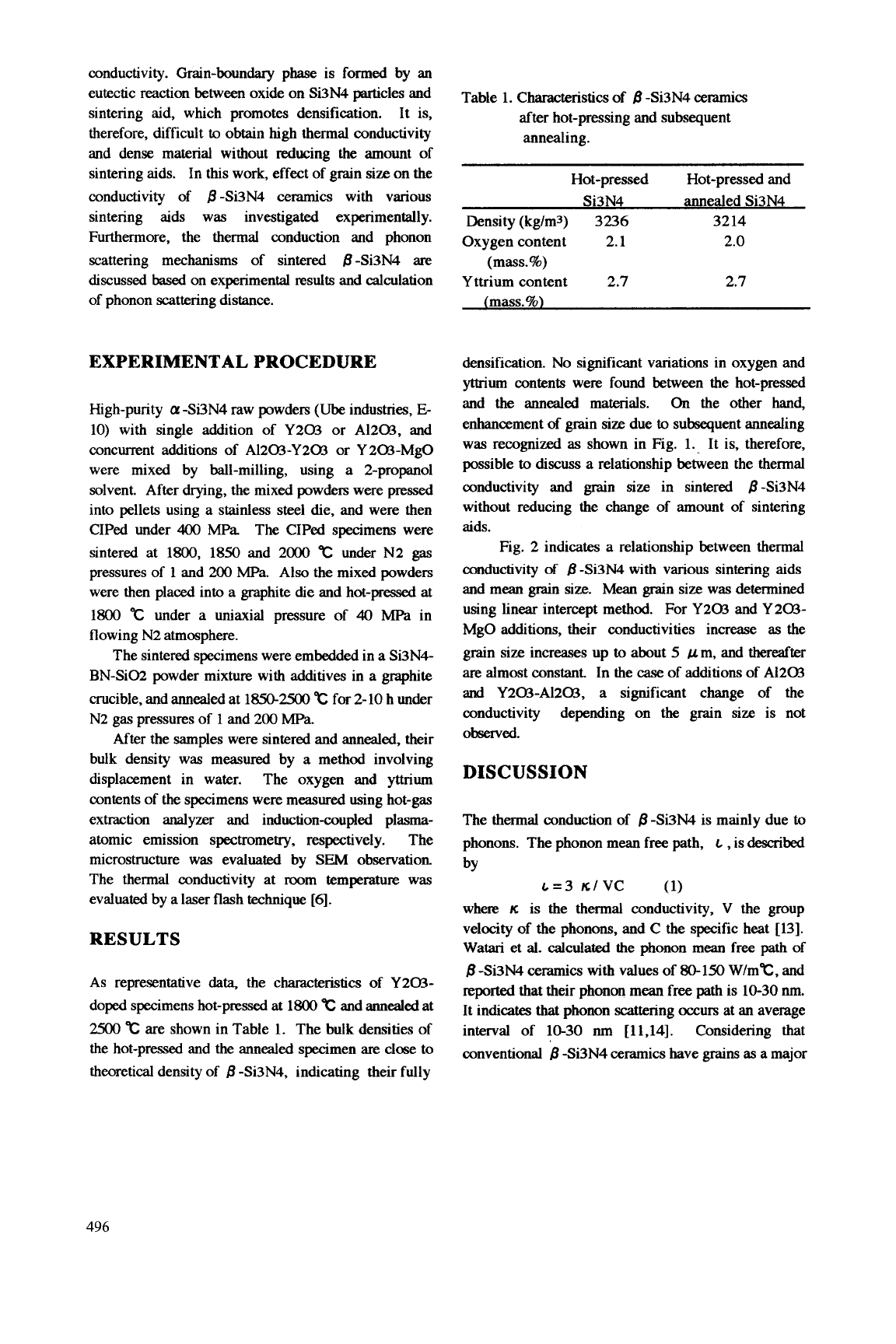
conductivity. Grain-boundary phase is formed by an
eutectic reaction between oxide on Si3N4 parhcles and
sintering aid, which promotes densification. It is,
therefore, difficult
to
obtain high thermal conductivity
and dense material without reducing the amount
of
sintering aids. In this work, effect
of
grain size on the
conductivity
of
B
-Si3N4 ceramics with various
sintering aids was investigated experimentally.
Furthermore, the thermal conduction and phonon
scattering mechanisms
of
sintered B-Si3N4
are
discussed
based
on experimental results and calculation
of
phonon scattering distance.
EXPERIMENTAL PROCEDURE
High-purity
a
-Si3N4 raw powders
(Ube
industries,
E-
10)
with single addition of Y203 or A1203, and
concurrent additions of A1203-Y203 or Y203-Mg0
were mixed by ball-milling, using a 2-propanol
solvent. After drymg, the mixed powders were pressed
into pellets using a stainless steel
die,
and were then
CIPed under
400
MPa The CIPed specimens were
sintered at 1800, 1850 and 2000
“c
under N2
gas
pressures
of
1 and 200 MPa. Also the mixed powders
were then placed into a graphite die and hot-pressed at
1800
“c
under a uniaxial pressure of
40
MPa
in
flowing N2 atmosphere.
The sintered specimens were embedded in a Si3N4-
BN-SiO;? powder mixture with additives in a graphite
crucible, and annealed at
1850-2500
“c
for 2-10 h under
N2
gas
pressures
of
1 and 200
MPa.
After the samples were sintered and annealed, their
bulk density was measured by
a
method involving
displacement in water. The oxygen and yttrium
contents
of
the specimens were
measured
using hot-gas
extraction analyzer and inductioncoupled plasma-
atomic emission spectrometry, respectively. The
microstructure was evaluated by
SEM
observation.
The thermal conductivity at room temperature
was
evaluated by a laser flash technique
[a.
RESULTS
As
representative
data,
the characteristics
of
Y203-
doped specimens hot-pressed
at
1800
“c
and annealed at
2500
“c
are
shown in Table
1.
The bulk densities of
the hot-pressed and the annealed specimen
are
close
to
theoretical density
of
B
-Si3N4, indicating their fully
Table
1.
Characterstics of
B
-Si3N4
cemnics
after hot-pressing and subsequent
annealing.
Hot-pressed Hot-pressed and
Si3N4 annealed Si3N4
Density (kglm3)
3236
32
14
Oxygen content 2.1 2.0
(mass.
%)
Yttrium content 2.7 2.7
(mass.%)
densification. No significant variations in oxygen and
yttrium contents were found between the hot-pressed
and
the
annealed materials.
On
the other hand,
enhancement
of
pn size due
to
subsequent annealing
was recognized
as
shown in Fig.
1.
It is, therefore,
possible
to
discuss
a
relationship between the thermal
conductivity and grain size in sintered B-Si3N4
without reducing the change of amount of sintering
aids.
Fig. 2 indicates a relationship between thermal
conductivity
of
B-Si3N4 with various sintering aids
and mean gain size. Mean grain size was determined
using linear intercept method. For
Y203
and Y 203-
MgO
additions, their conductivities increase
as
the
grain size increases up
to
about
5
j~m, and thereafter
are
almost constant. In the
case
of additions
of
A1203
and
Y203-Al203, a significant change of the
conductivity depending on the grain size
is
not
Observed.
DISCUSSION
The thermal conduction
of
B
-Si3N4 is mainly due
to
phonons. The phonon mean
free
path,
L
,
is
described
bY
G=3
KlVC
(1)
where
K
is the thermal conductivity,
V
the group
velocity of the phonons, and C the specific heat 1131.
Watari et
al.
calculated the phonon mean free path
of
B
-Si3N4
ceramics
with values
of
80-150
W/m“c, and
reported
that their phonon
mean
free path is
10-30
nm.
It indicates
that
phonon scattering occurs at an average
interval
of
10-30
nm [11,14]. Considering that
conventional
b
-Si3N4 ceramics have grains
as
a major
496
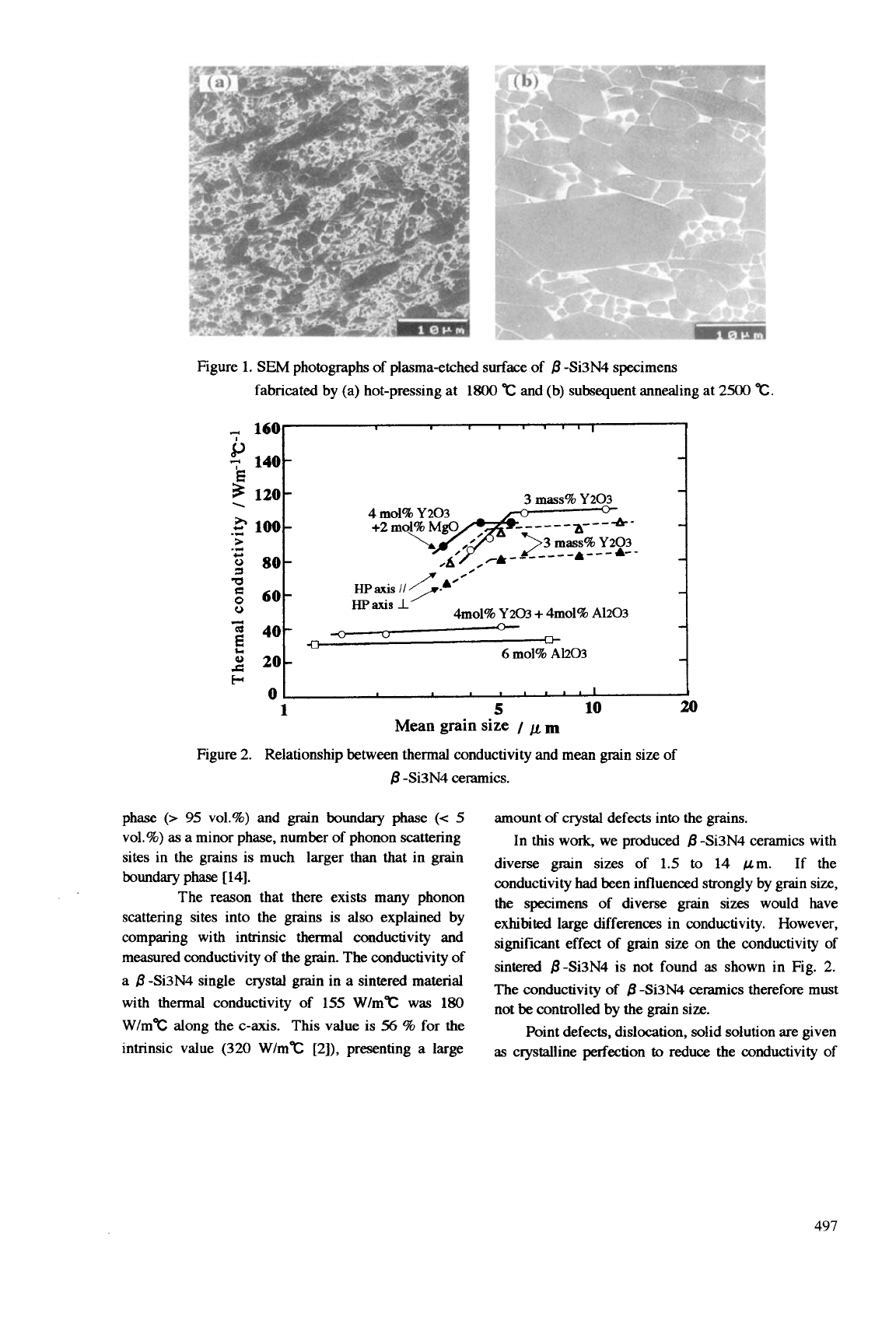
Figure
1.
SEM
photographs of plasma-etched surface
of
B
-Si3N4 specimens
fabricated by (a) hot-pressing at
1800
"c
and (b) subsequent annealing at
2500
"c.
3
40-
L.l
2
20-
b
0
--c+
-
6
mol%
A1203
-
I
phase
(>
95
vol.%) and grain boundary phase
(<
5
vol.%)
as
a
minor phase, number of phonon scattering
sites in the grains
is
much larger than that in grain
boundary phase
[
141.
The reason that there exists many phonon
scattering sites into the grains is
also
explained by
comparing with intrinsic thermal conductivity and
measured conductivity of the grain. The conductivity of
a
B
-Si3N4 single crystal grain in
a
sintered material
with thermal conductivity
of
155
W/m"C
was
180
W/m"c along the c-axis. This value is
56
%
for the
intrinsic value
(320
W/m"c
[2]),
presenting
a
large
amount of crystal defects into the grains.
In this
work,
we produced
B
-Si3N4 ceramics with
diverse grain sizes of
1.5
to
14
am. If the
conductivity had been influenced strongly by grain size,
the speamens of diverse grain sizes would have
exhibited
large differences in conductivity. However,
significant effect
of
grain
size
on the conductivity
of
sintered B-Si3N4
is
not found
as
shown
in
Fig.
2.
The conductivity of
B
-Si3N4 ceramics therefore must
not be controlled by the grain
size.
Point defects, dislocation, solid solution
are
given
as
crystalline perfection
to
reduce the conductivity
of
497
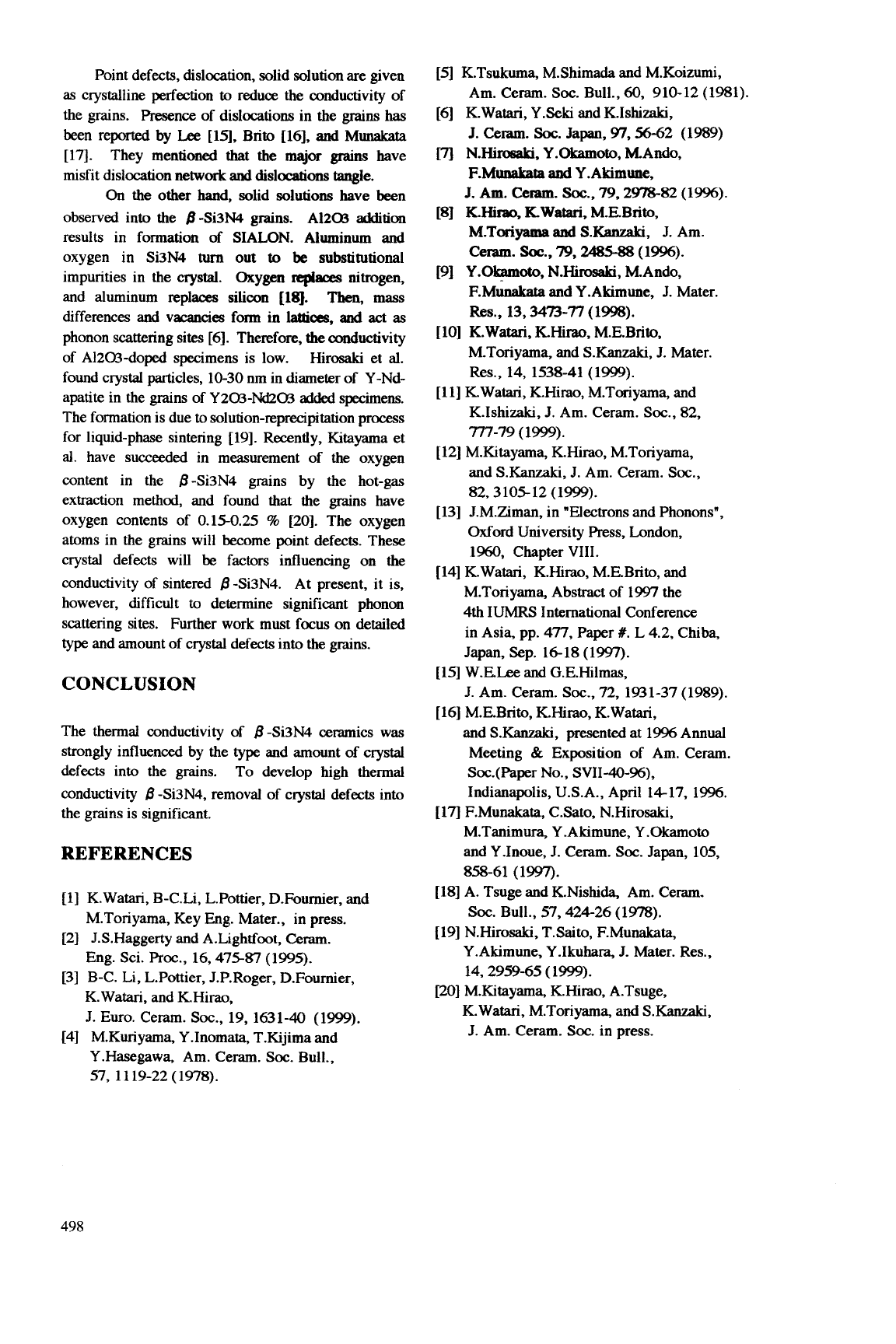
Point defects, dislocation, solid solution are given
as
crystalline perfection
to
reduce the conductivity of
the grains.
Presence
of
dislocations in the
grruns
has
been reported by
Lee
[la,
Brito
[16],
and
Munakata
[17]. They mentioned
that
the
major
grains
have
misfit dislocation network
and
dislocations
tangle.
On
the other
hand,
solid solutions have been
observed into the B-Si3N4 grains. A1203
addition
results in formation
of
SIALON. Aluminum
and
oxygen in Si3N4
turn
out
to
be
substitutional
impurities in the crystal. Oxygen
repiaces
nitrogen,
and aluminum replaces
silicon
(183.
Then,
mass
differences
and
vacancies
form
in
lattices,
and
act
as
phonon scattering sites
[6].
Therefore,
the
conductivity
of A12CX-doped specimens is low. Hirosaki et
al.
found crystal particles, 10-30 nm in diameter of Y-Nd-
apatite in the puns
of
Y2CX-Nd203
added
specimens.
The formation is due
to
solution-reprecipitation process
for liquid-phase sintering
[19].
Recently, Kitayama et
al.
have
succeeded
in measurement of the oxygen
content in the B-Si3N4 grains by the hot-gas
extraction method, and found that the grains have
oxygen contents
of
0.150.25
%
[20].
The oxygen
atoms in the grains will become point defects. These
crystal defects will
be
factors
influencing on the
conductivity of sintered B-Si3N4. At present, it is,
however, difficult
to
determine significant phonon
scattering sites. Further work must
focus
on detailed
type and amount
of
crystal defects into the
grains.
CONCLUSION
The thermal conductivity
d
B-Si3N4 ceramics was
strongly influenced by the type and amount of crystal
defects into the grains. To develop high thermal
conductivity
B
-Si3N4, removal of crystal defects into
the grains is significant.
REFERENCES
[l]
K.Watari, B-C.Li, L.Pottier, D.Fournier, and
M.Toriyama, Key
Eng.
Mater., in press.
[Z]
J.S.Haggerty and A.Lightfmt, Ceram.
Eng. Sci.
Proc.,
16,47587
(1995).
[3]
B-C. Li, L.Pottier, J.P.Roger, D.Fournier,
K.
Watari, and KHirao.
J.
Euro.
Ceram.
Soc.,
19, 1631-40 (1999).
[4]
M.Kuriyama,
Y
.Inomata, T.Kijima and
Y.Hasegawa, Am. Ceram.
Soc.
Bull.,
57,
11 19-22 (1978).
[5]
K.Tsukuma, MShimada and M.Koizumi,
[6]
K.Watari,
Y.Seki
and K.Ishtzaki,
Am. Ceram.
Soc.
Bull.,
60,
910-12 (1981).
J.
Ceram.
Soc.
Japan,
97,5642
(1989)
N.Hid, Y.Okamot0, M.Ando,
F.Md
and
Y .Akimune,
J.
Am.
Ceram.
Soc.,
79,2978-82
(1%).
[8]
K.Hirao,
KWatari,
M.EBrito,
M.Toriyama
and
S.Kanzaki,
J. Am.
ceram.
soc.,
79,2485-88
(19%).
191
Y
.Okamoto,
N.HiW,
M.Ando,
EMunakata
and
Y.Akimune, J. Mater.
Res.,
13,3473-77
(1998).
[
101
K.Watari,
KHirao,
M.E.Brito,
M.Toriyama, and
S.Kanzaki,
J. Mater.
Res.,
14,
1538-41 (1999).
[
1
11
K.
Watari, K.Hirao, M.Toriyama, and
K.Ishizaki,
J.
Am. Ceram.
Soc.,
82,
777-79
(1999).
and
S.Kanzaki,
J. Am. Ceram.
Soc.,
82,310512
(1999).
[13]
J.M.Ziman, in "Electrons and Phonons",
Oxford University
Press,
London,
1%0.
Chapter VIII.
[
141
K.Watari, K.Hirao, M.E.Brito, and
M.Toriyama, Abstract of 1997 the
4th IUMRS International Conference
in Asia, pp.
477,
Paper
#.
L 4.2, Chiba,
Japan, Sep. 16-18 (1997).
[15l
W.ELee
and
G.E.Hilmas,
J.
Am. Ceram. Soc.,72, 1931-37(1989).
[16]
M.E.Brito, K.Hirao,K.Watari,
and
S.Kanzalu,
presented at
1996
Annual
Meeting
&
Exposition
of
Am. Ceram.
Soc.(Paper
No.,
SVII-40-%),
Indianapolis, U.S.A., April 1417, 1996.
M.Tanimura, Y.Akimune, Y.Okamoto
and Y.Inoue, J. Ceram.
Soc.
Japan,
105,
[12] M.K~tayama, K.Hirao, M.Toriyama,
[17]
F.Munakata, C.Sato, N.Hirosaki,
858-61
(1997).
[18]
A. Tsuge and K.Nishida, Am. Ceram.
[19]
N.Hirosaki, T.Saito, EMunakata,
SOC.
Bull., 57,424-26 (1978).
Y.Akimune, Y.Ikuhara,
J.
Mater. Res.,
14,2959-65
(1999).
W]
M.Kitayama, K.Hirao, A.Tsuge,
KWatari, M.Toriyama,
and
S.Kanzaki,
J. Am. Ceram.
Soc.
in press.
498
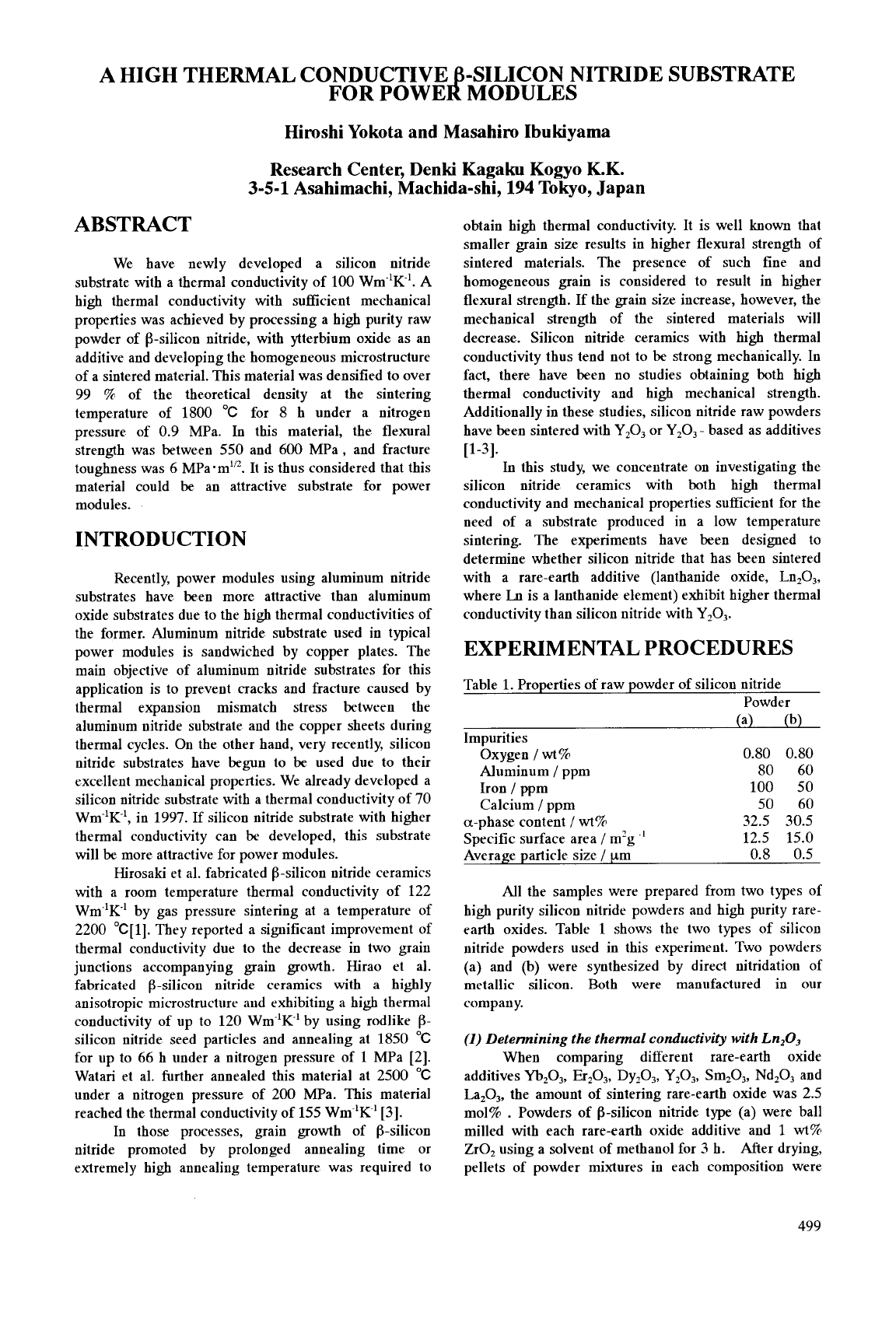
A HIGH THERMAL CONDUCTIVE
-SILICON NITRIDE SUBSTRATE
FOR POWE
P
MODULES
Hiroshi Yokota and Masahiro Ibukiyama
Research Center, Denki Kagaku Kogyo K.K.
3-5-1
Asahimachi, Machida-shi,
194
Tokyo, Japan
ABSTRACT
We have newly developed a silicon nitride
substrate with a thermal conductivity of
100
Wm-'K-'. A
high thermal conductivity with sufficient mechanical
properties was achieved by processing a high purity raw
powder of p-silicon nitride, with ytterbium oxide as an
additive and developing the homogeneous microstructure
of a sintered material. This material was densified to over
99
%
of the theoretical density at the sintering
temperature
of
1800 "C for
8
h
under a nitrogen
pressure of
0.9
MPa. In this material, the flexural
strength was between 550 and 600 MPa, and fracture
toughness was 6 MPa*m"2. It is thus considered that this
material could be an attractive substrate for power
modules.
INTRODUCTION
Recently, power modules using aluminum nitride
substrates have been more attractive than aluminum
oxide substrates due to the high thermal conductivities of
the former. Aluminum nitride substrate used in typical
power modules is sandwiched by copper plates. The
main objective of aluminum nitride substrates for this
application is to prevent cracks and fracture caused by
thermal expansion mismatch stress between the
aluminum nitride substrate and the copper sheets during
thermal cycles.
On
the other hand, very recently, silicon
nitride substrates have begun to be used due
to
their
excellent mechanical properties. We already developed
a
silicon nitride substrate with
a
thermal conductivity of
70
Wm-'K-', in 1997. If silicon nitride substrate with higher
thermal conductivity can be developed, this substrate
will
be
more attractive for power modules.
Hirosaki et al. fabricated p-silicon nitride ceramics
with a room temperature thermal conductivity of 122
Wm'K" by gas pressure sintering at a temperature
of
2200 "C[l]. They reported a significant improvement of
thermal conductivity due to the decrease in two grain
junctions accompanying grain growth. Hirao et al.
fabricated p-silicon nitride ceramics with
a
highly
anisotropic microstructure
aid
exhibiting
a
high thermal
conductivity of up to 120 Wm
'K1
by using rodlike
p-
silicon nitride seed particles and annealing at
1850
"C
for up to 66
h
under
a
nitrogen pressure of
1
MPa [2].
Watari et al. further annealed this material at 2500 "C
under
a
nitrogen pressure of 200 ma. This material
reached the thermal conductivity of
155
Wm 'K-'
[3].
In those processes, grain growth
of
p-silicon
nitride promoted by prolonged annealing time or
extremely high annealing temperature was required to
obtain high thermal conductivity. It is well
known
that
smaller grain size results in higher flexural strength of
sintered materials. The presence of such fine and
homogeneous grain is considered to result in higher
flexural strength. If the grain size increase, however, the
mechanical strength of the sintered materials will
decrease. Silicon nitride ceramics with high thermal
conductivity thus tend not to
be
strong mechanically. In
fact, there have been
no
studies obtaining both high
thermal conductivity and high mechanical strength.
Additionally in these studies, silicon nitride raw powders
have been sintered with
Y,O,
or
Y,O,
-
based as additives
In
this study, we concentrate
on
investigating the
silicon nitride ceramics with both high thermal
conductivity and mechanical properties sufficient for the
need of a substrate produced in a low temperature
sintering. The experiments have been designed to
determine whether silicon nitride that has been sintered
with a rare-earth additive (lanthanide oxide,
Ln,O,,
where
Ln
is
a lanthanide element) exhibit higher thermal
conductivity than silicon nitride with
Y203.
[l-31.
EXPERIMENTAL PROCEDURES
Table
1.
Properties of raw powder of silicon nitride
Powder
(a) (b)
Impurities
Oxygen
1
wt%
0.80
0.80
Aluminum / ppm
80
60
Iron
1
ppm
100
50
Calcium / ppm
50
60
a-phase content
/
wt%
32.5
30.5
Specific surface area
/
m'g
'
12.5 15.0
Average particle size
/ pm
0.8
0.5
All the samples were prepared from two types of
high purity silicon nitride powders and high purity rare-
earth oxides. Table
1
shows the two types of silicon
nitride powders used in this experiment. Two powders
(a) and (b) were synthesized by direct nitridation
of
metallic silicon. Both were manufactured in
our
company.
(1)
Determining the thermal conductivity with Ln,O,
When comparing different rare-earth oxide
additives
Yb,O,,
Er,O,,
Dyz03,
Y,O,,
Sm,O,, Nd,03 and
La,O,, the amount of sintering rare-earth oxide was 2.5
mol%
. Powders of p-silicon nitride type (a) were ball
milled with each rare-earth oxide additive and
1
wt%
ZrO, using a solvent of methanol for
3
h.
After drying,
pellets of powder mixtures in each composition were
499
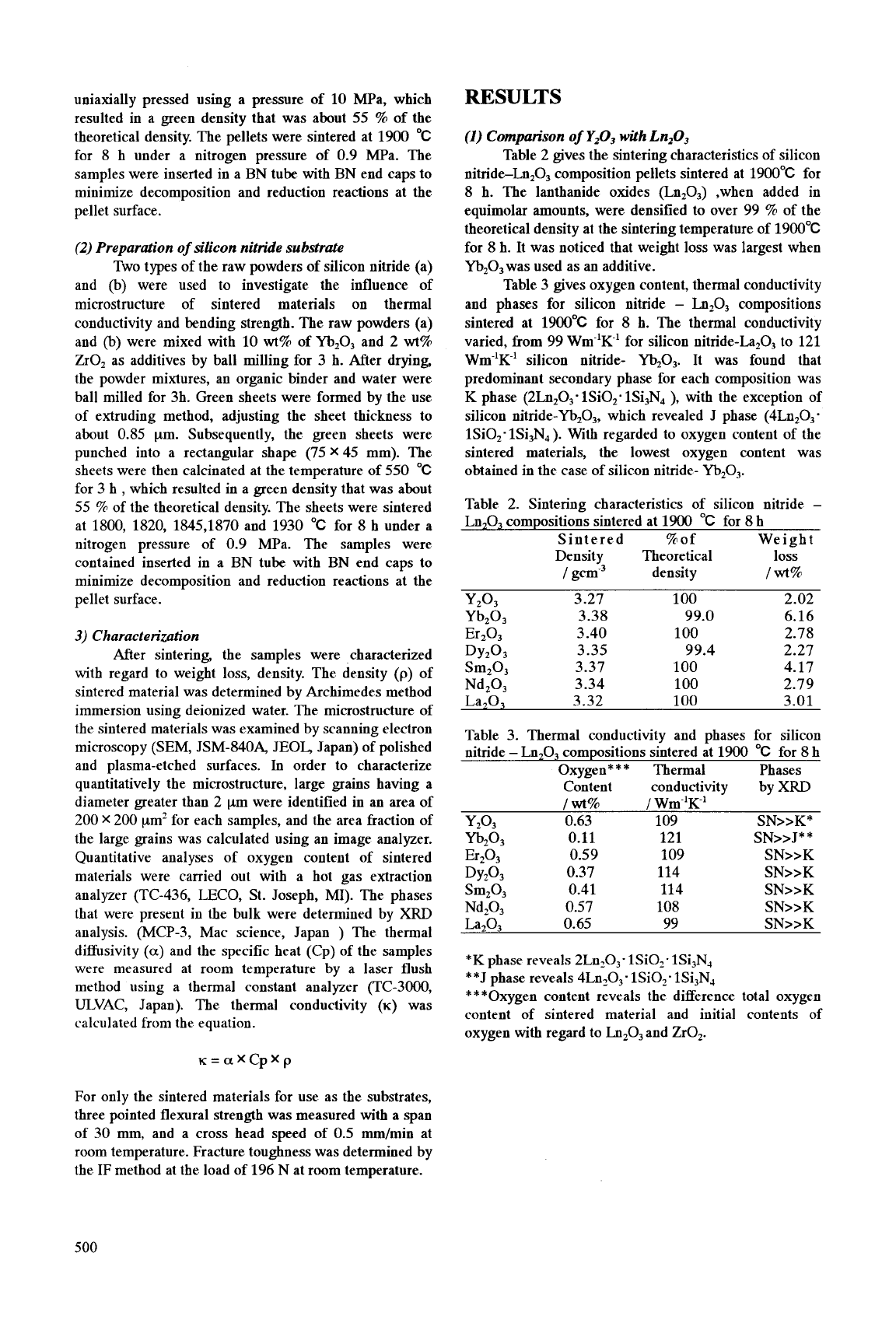
uniaxially pressed using a pressure of
10
MPa, which
resulted in a green density that was about
55
9%
of the
theoretical density. The pellets were sintered at
1900
"C
for
8
h
under a nitrogen pressure of
0.9
MF'a. The
samples were inserted in a BN tube with BN end caps to
minimize decomposition and reduction reactions at the
pellet surface.
(2)
Preparation
of
silicon
nitride substrate
Two types of the raw powders
of
silicon nitride (a)
and
(b)
were used to investigate the influence of
microstructure of sintered materials
on
thermal
conductivity and bending strength. The raw powders (a)
and
(b)
were mixed with
10
wt%
of
Yb,O,
and 2
wt%
ZrO, as additives by ball milling for
3
h.
After drying,
the powder mixtures, an organic binder and water were
ball milled for 3h. Green sheets were formed by the use
of extruding method, adjusting the sheet thickness to
about
0.85
pm. Subsequently, the green sheets were
punched into a rectangular shape (75x45 mm). The
sheets were then calcinated at the temperature of
550
"C
for
3
h
,
which resulted in a green density that was about
55
5%
of the theoretical density. The sheets were sintered
at
1800,
1820,
1845,1870
and
1930
"C
for
8
h
under a
nitrogen pressure of 0.9 MPa. The samples were
contained inserted in a BN tube with BN end caps to
minimize decomposition and reduction reactions at the
pellet surface.
3)
Characterization
After sintering, the samples were characterized
with regard to weight loss, density. The density
(p)
of
sintered material was determined by Archimedes method
immersion using deionized water. The microstructure of
the sintered materials was examined by scanning electron
microscopy (SEM, JSM-8404 JEOL, Japan) of polished
and plasma-etched surfaces.
In
order to characterize
quantitatively the microstructure, large grains having a
diameter greater than 2 pm were identified in an area of
200
X
200
pm' for each samples, and the area fraction of
the large grains was calculated using an image analyzer.
Quantitative analyses of oxygen content of sintered
materials were carried out with a hot gas extraction
analyzer (TC-436, LECO,
St.
Joseph, MI). The phases
that were present in the bulk were determined by
XRD
analysis. (MCP-3, Mac science, Japan
)
The thermal
diffusivity
(a)
and the specific heat (Cp) of the samples
were measured
at
room temperature by a laser flush
method using
a
thermal constant analyzer (TC-3000,
ULVAC, Japan). The thermal conductivity
(K)
was
calculated from the equation.
RESULTS
(1)
Comparison
of
Y203
with
Ln,03
Table 2 gives the sintering characteristics of silicon
nitride-Ln,03 composition pellets sintered
at
1900°C for
8
h.
The lanthanide oxides (Ln,O,) ,when added in
equimolar amounts, were densified to over
99
9%
of the
theoretical density at the sintering temperature of 1900°C
for
8
h.
It was noticed that weight loss was largest when
Yb203
was used as an additive.
Table
3
gives oxygen content, thermal conductivity
and phases for silicon nitride
-
Ln203
compositions
sintered at 1900°C for
8
h.
The thermal conductivity
varied,
from
99
Wm
'K
for silicon nitride-La,03 to 121
Wm-'K-' silicon nitride-
Yb203.
It was found that
predominant secondary phase for each composition was
K
phase (2Ln,03- lSi0,. lSi,N,
),
with the exception of
silicon nitride-Ybz03, which revealed J phase (4Ln,O3-
1SiO; 1Si3N4). With regarded to oxygen content of the
sintered materials, the lowest oxygen content was
obtained in the case
of
silicon nitride-
Yb,O,.
Table 2. Sintering characteristics of silicon nitride
-
Lnz03
compositions sintered at
1900
"C for
8
h
Sintered %of Weight
Density Theoretical loss
1
gcm
density
I
wt%
YZO, 3.27
100
2.02
YbZO,
3.38
99.0
6.16
ErZ03
3.40
100
2.78
Dy2°3
3.35
99.4 2.27
Sm203
3.37
100 4.17
Nd203
3.34
100
2.79
La,O, 3.32
100
3.01
Table
3.
Thermal conductivity and phases for silicon
nitride
-
Ln,03
compositions sintered at
1900
"C for
8
h
Oxygen*
*
*
Thermal Phases
Content conductivity by
XRD
0.11
121 SN>>J*
*
ErZ03
0.59
109
SN>>K
DyZ03
0.37
114
SN>>K
Sm203
0.41 114
SN>>K
Nd,03
0.57
108
SN>>K
La,O,
0.65
99
SN>>K
*K
phase reveals
2Ln,O,-
lSiO,-lSi,N,
**J phase reveals 4Ln,0,-1Si0,-1Si,N4
***Oxygen content reveals the difference total oxygen
content of sintered material and initial contents of
oxygen with regard to
Ln,O,
and ZrO,.
K
=
ax
cp
x
p
For only the sintered materials for use as the substrates,
three pointed flexural strength was measured with a span
of
30
mm, and a cross head speed
of
0.5
mm/min at
room temperature. Fracture toughness was determined by
the IF method at the load of
196
N at room temperature.
500
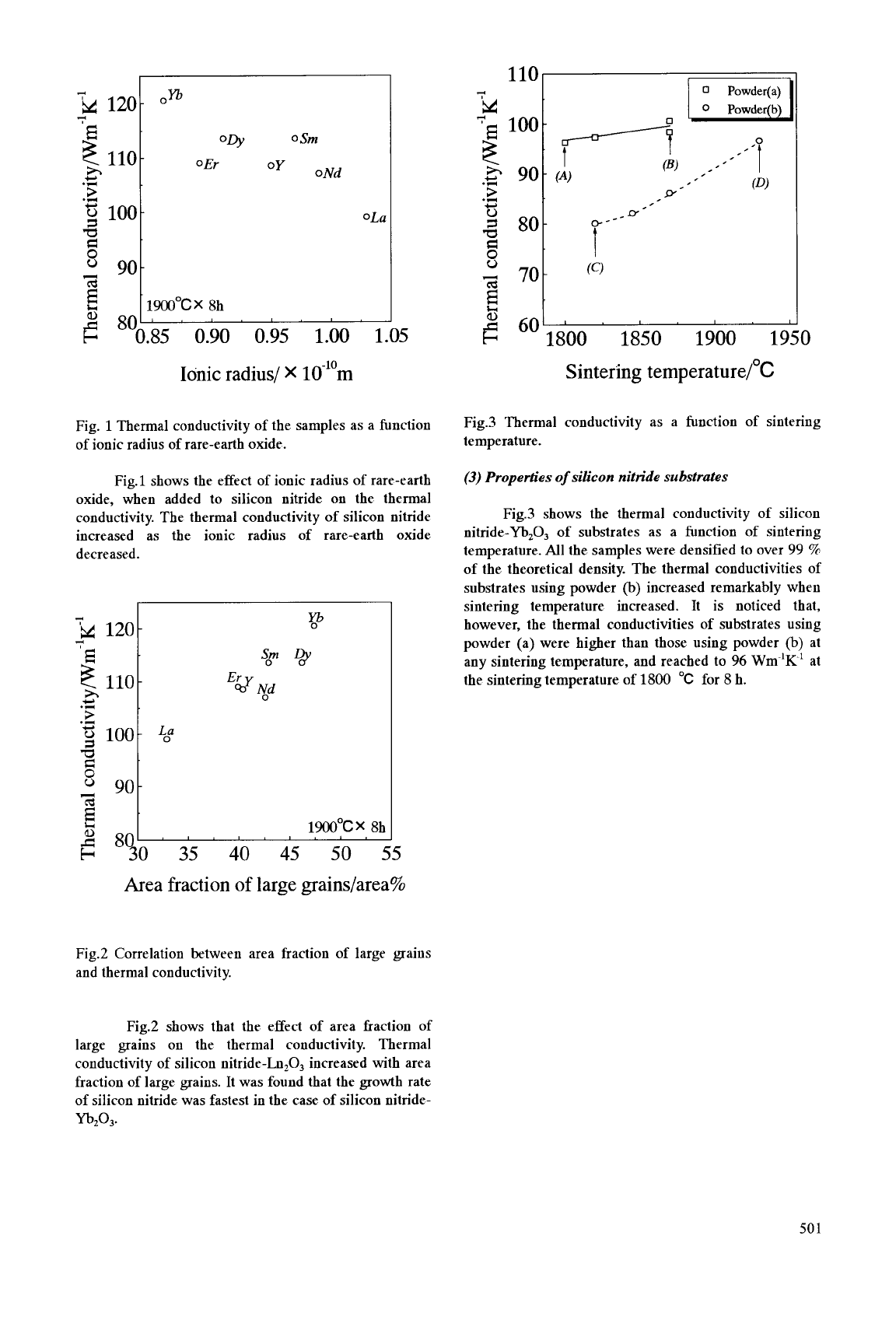
1201
*
80
t
om
0
Sm
loot
oLa
Fig.
1
Thermal conductivity of the samples as a function
of ionic radius of rare-earth oxide.
Fig.l shows the effect of ionic radius of rare-earth
oxide, when added to silicon nitride
on
the thermal
conductivity. The thermal conductivity of silicon nitride
increased as the ionic radius of rare-earth oxide
decreased.
Area fraction of large grains/area%
Fig.2 Correlation between area fraction of large grains
and thermal conductivity.
110
100
3
L4
5
.M
5
90
>
.cI
c
a
2
80
0
3
-
70
a
Powder(a)
I
Powder(b)
I
n
sintering temperature/OC
Fig.3 Thermal conductivity as a function of sintering
temperature.
(3)
Properties
of
silicon nitride substrates
Fig.3 shows the thermal conductivity of silicon
nitride-Yb,03 of substrates
as
a function of sintering
temperature. All the samples were densified to over
99
%
of the theoretical density. The thermal conductivities of
substrates using powder
(b)
increased remarkably when
sintering temperature increased. It
is
noticed that,
however, the thermal conductivities of substrates using
powder (a) were higher than those using powder
@)
at
any sintering temperature, and reached to
96
Wm
'K
'
at
the sintering temperature of
1800
"C
for
8
h.
Fig.2 shows that the effect of area fraction of
large grains
on
the thermal conductivity. Thermal
conductivity of silicon nitride-Ln203 increased with area
fraction of large grains. It was found that the
growth
rate
of silicon nitride was fastest in the case of silicon nitride-
50
1
